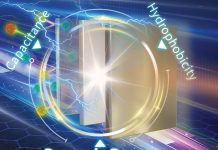
Perovskite solar cells are a promising technology for renewable energy. They are lightweight, flexible, easy to make, and inexpensive.
They can be attached to many different surfaces, making them highly versatile.
However, current perovskite solar cells have some drawbacks—they are not very durable and tend to be inefficient.
A new study, published in Energy Materials and Devices, shows that adding a polymerized ionic liquid to the metal halide perovskite material can significantly improve the performance of these solar cells.
“The common solution processing method for making perovskite layers creates many defects in both the bulk and surface of the perovskite layer.
These defects limit the overall performance of the devices,” explains Qi Cao, a researcher at Northwestern Polytechnical University in Xi’an, China.
To overcome these defects, researchers use a technique called additive engineering. This method has proven effective in reducing defects and improving the performance of perovskite solar cells.
In this study, the researchers developed a polymerized ionic liquid called poly4-styrenesulfonyl(trifluoremethylsulfonyl)imidepyridine, or PSTSIPPyri for short. Adding PSTSIPPyri to the metal halide perovskite solar cell offers many benefits.
It prevents halide ion migration, helping maintain the crystal structure, and fixes organic and halide ions, which improves the solar cell’s stability.
“Researchers have focused on finding additives that enhance the performance of perovskite solar cells. Ionic liquids have received widespread attention because they are strong, stable, and have tunable properties like viscosity, polarity, and conductivity,” says Xuanhua Li, another researcher at Northwestern Polytechnical University.
“This tunability allows us to fine-tune the ionic liquid properties to meet the specific needs of the perovskite film, optimizing device performance.”
To test the effectiveness of PSTSIPPyri, the researchers conducted extensive studies on the perovskite solar cells with this poly ionic liquid. They aged the perovskite films for 300 hours at 85°C and 60% relative humidity. The enhanced perovskite film showed a slower rate of degradation compared to the control film without the poly ionic liquid.
In high humidity and high heat environments, the perovskite solar cell with PSTSIPPyri maintained 84.5% of its efficiency after 1,000 hours, while the control cell only maintained 43.6% of its initial efficiency.
Durability is a crucial factor for perovskite solar cells. The study found that with the addition of PSTSIPPyri, the perovskite solar cell maintained 87.6% of its power conversion efficiency after 1,500 hours of continuous light exposure, compared to the control cell, which only maintained 61.1% efficiency.
“Incorporating PSTSIPPyri as an additive significantly boosts the power conversion efficiency of inverted perovskite solar cells from 22.06% to 24.62%. They also show excellent long-term operational stability,” says Cao. “This strategy demonstrates the potential of poly ionic liquids as a promising additive for perovskite solar cells, offering both high performance and stability.”
This research suggests that polymerized ionic liquids like PSTSIPPyri can play a crucial role in enhancing the efficiency and durability of perovskite solar cells, paving the way for their wider adoption in the future.



